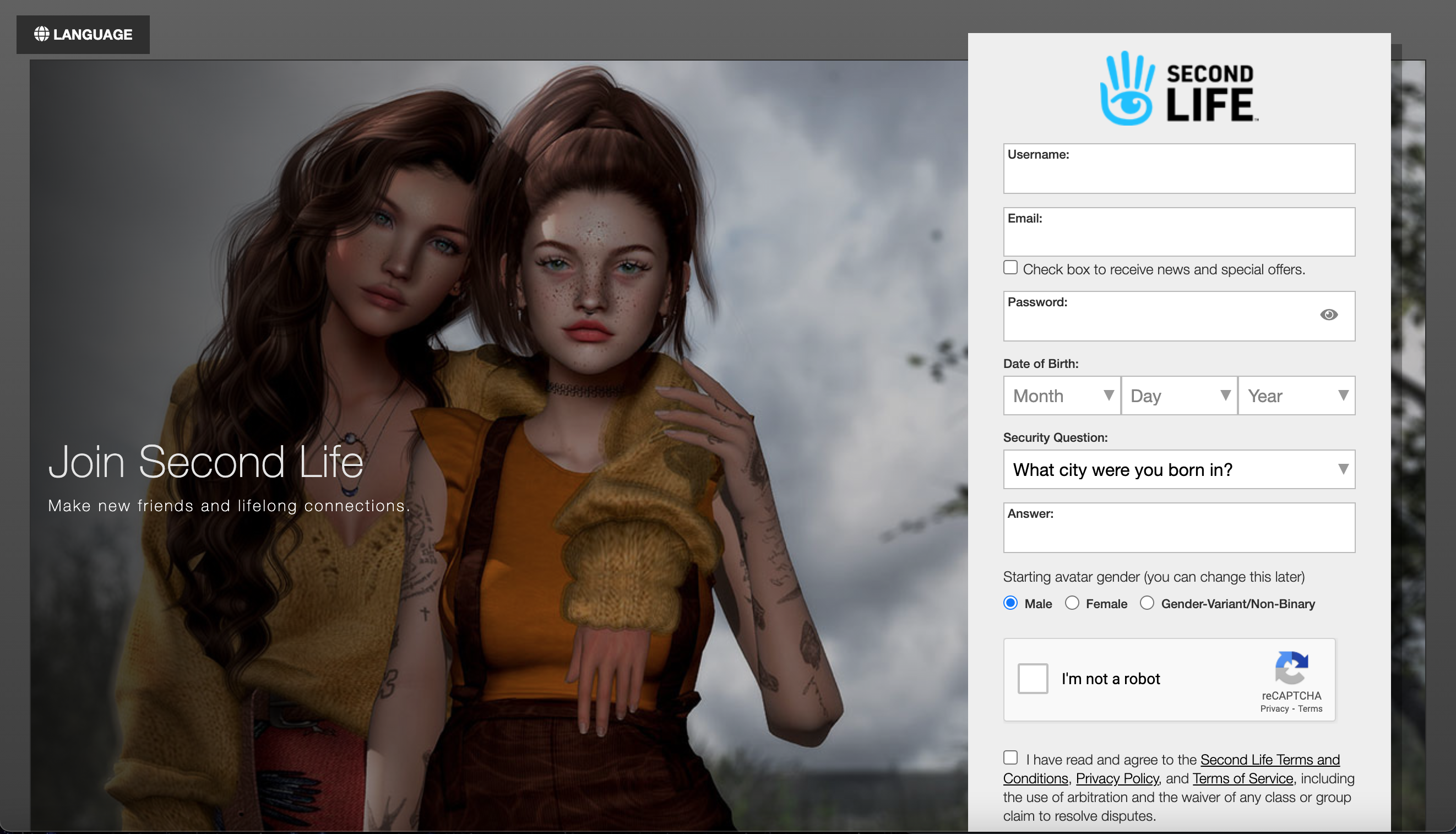The First-Hour Experience

Since we’re still during the holiday season, here goes a wishlist, which is probably compiled from our collective mind, and these are almost always pointed out as the major reasons for new users to drop out:
Stop lag! While this is naturally just wishful thinking — to “stop lag”, a major architectural redesign would be required at the level of the grid infrastructure. This won’t happen. The best we can hope for are small improvements here and there, like some new LSL functions which will dramatically reduce the number of running scripts, or merely addressing the wasteful memory some scripts are actually taking which impact the servers’ performance dramatically.
Create a simpler SL client! When the SL Viewer was released as open source, there were great expectations that someone would just take it and change it completely, creating a version that would run on basically every low-end computer out there, or possibly even on a web page. Reality stepped in, and what we have today are mostly tweaked versions of the base client, with bug fixes, patches, small improvements here and there (which, however, often have a huge impact!), and some extra functionality. But basically the SL Viewer is the same, the rendering engine is the same, and, more importantly, the user interface hasn’t changed much. I still have high hopes that the Imprudence team brings out something staggeringly new, but this will happen over several years — not months. As all developers engaged in the viewer have found out, this is a beastly huge codebase, which is not so easy to change — or to simplify. Rumours of a “new viewer” (even sometimes referred as “SL 2.0“) abound, but it’s clear that it won’t be launched so soon as we all expected it to be, and very likely, it will have far less changes than we would like it to have.
I personally expect this “SL 2.0” viewer to be the one that includes shadows, meshes, clickable-HTML-and-Flash-on-a-prim, and the mashup between landmarks and SLURLs. All this is under development in several stages, and launching them all together in the same viewer would make some sense. But it won’t be a “simpler” or “lighter” viewer: the best we can hope for is an option for a smaller set of menus and options when you install the viewer for the first time (for instance, the “Build” button and the “Tools” menu might simply not exist unless activated).
Give newbies L$! As stupid as this might sound, Second Life, for several years, actually had a subsidised economy: every Basic account would get L$50 per week if they logged in during that week. A rating system actually allowed you to earn some extra money that way — if you were rated positively often enough, you’d get a bonus. And finally, if you owned land, and you had a lot of traffic, you’d also get more money. The overall idea was that residents with a stipend would participate more in the economy, and thus foster its growth. Very social democratic of the Lindens 🙂 But the truth is that this kick-started the whole economy, until, of course, like everything else, it was so heavily gamed, and was threatening inflation, that Linden Lab had to put a stop to it.
Nevertheless, many other options have existed on other platforms to give newbies some cash. “Gold mining” is the most obvious case, but some people, like SignpostMarv Martin, even suggested an Achievements system. This could be tied to a small prize incentive in L$. Many residents, specially the ones in close contact with newbies, feel that one of the reasons newbies give up SL so early is that they don’t get any incentives to stay. Some will find their own incentives, of course; but most of the people in this age, at least in the Western World, don’t know how to entertain themselves. They are used to be entertained passively — they’re the TV and console games generation. Somehow giving them some “goals” — like finding things in SL, adding N friends, clicking on X profiles, visiting Y places, etc. — would provide them with some entertainment, and make them stay longer in SL. The ideas might have some merit, but Linden Lab still believes they’re better implemented by residents, not by the company itself. And, indeed, some people actually have built successful business models around these ideas, like the ConeNet (where you get paid a few L$ to teleport to advertisers’ parcels) or Job Island. There are lots and lots of similar schemes where everybody profits — newbies get a handful of L$, which are paid for sponsors, and the service provider gets a share too.
Make a better search engine! This is something that clearly most users think that should be dramatically improved. Ironically, the internal search engine is actually a Google Search Appliance — the very same technology used by Google on its search engine. One would thus expect utterly amazing performance and ease of search. Alas, as Linden Lab has found out — and so have we all! — searching 2D content is rather not the same thing as searching for 3D content. A few were actually hopeful that buying XstreetSL would give Linden Lab a better search tool; others, by contrast, think that XStreetSL’s own search tool is even worse than Second Life’s.
I personally have no idea how the search could be improved. My own experience shows that these days there is simply too much content — either on the Web or inside SL — to “get lucky” with a handful of keywords on a search. In my opinion, the only way that you can get better search results is to search on the results themselves. Even Google doesn’t make that very easy. But that’s actually how humans proceed when they search for things. Imagine you need to find an article about, say, ancient Roman coins, to check if a coin you just found on your backyard is worth anything, and for some obscure reason you don’t have Internet access. Your first task might be to ask yourself, what are my choices? You might go to a museum, and look up all coins and see if any matches yours. Or you might go from numismatic shop to numismatic shop and ask questions about your coin. Or you might just go to the closest library and see if you can get a visual match on a magazine or a book. Choosing the library, you might ask the assistant about “coins”, and she’ll show you a lot of choices: whole shelves about ancient history; shelves about coins from all periods; magazines with pictures of coins with issues from the past five decades. It’s time to narrow it down! You might imagine that magazines might have better pictures, so you just narrow down to the issues covering a specific period. Then you open the index page, and turn to “Roman coins”. And then you start matching the coin in your hand with the picture.
I can imagine that a similar model might work for SL, too. You’d start with a broad search in SL with, say, “clothes” — but note that this is different from “category browsing”, which is always a mess — unless done by a professional librarian, and the searcher knows what kind of categories librarians use, there will always be problems of classification. Are shoes files under “clothes” or “accessories”? (Possibly the creator is not sure and classifies it wrongly under “clothes”). So a free-text search is best. But then you wish to narrow down the choices: only clothes from, say, 2009; only clothes for females; only goth; only black; only complete outfits. Now, you might say that you can do that today with a clever search, using queries like +clothes -accessories +2009 +goth +black +outfit — but as you can see, Google’s engine will still match too many things, and some are simply irrelevant to what you wish to find. Google is a “general purpose” engine.
Instead, I’d prefer a search engine like eBay’s. Although I can understand that many people are not happy about eBay’s search engine either, I find it works quite well for a shopping experience — which is, I bet, the major reason for people to use Search in SL, i.e. to find products and services. eBay’s engine is even rather good at dealing with misclassified products; it also allows for free-form search (say, when there is a specific shade of colour you have in mind, and this was not foreseen by eBay’s developers); it allows you to do “pivot” searching, which means you start by looking for things, then look up all items for sale from a specific merchant, then turn back to searching for a specific category. I can’t say I’m an expert e-Bayer, but I find their search engine rather good for my personal use. I almost never get “too many” articles on the searches, but “just the articles” I’m looking for, which is, in my opinion, the whole point of a marketplace’s search engine.
Beyond those ideas, many people have a lot of suggestions, but it’s not always clear what the majority thinks it’s worthwhile to explore.


Recent Comments